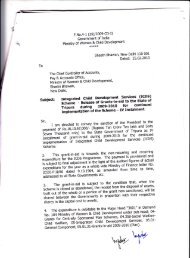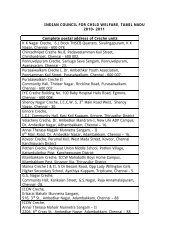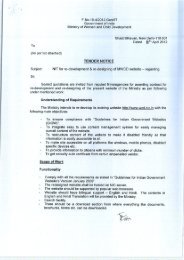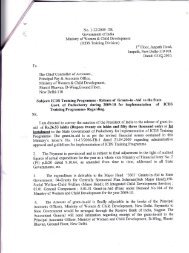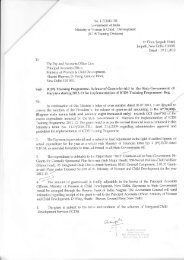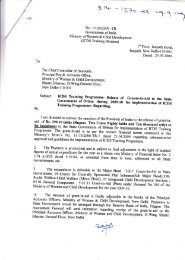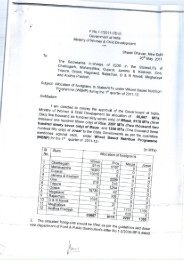COVER HINDI - Ministry of Women and Child Development
COVER HINDI - Ministry of Women and Child Development
COVER HINDI - Ministry of Women and Child Development
- TAGS
- hindi
- ministry
- wcd.nic.in
You also want an ePaper? Increase the reach of your titles
YUMPU automatically turns print PDFs into web optimized ePapers that Google loves.
2<br />
1.8<br />
1.6<br />
1.4<br />
1.2<br />
1<br />
0.8<br />
0.6<br />
0.4<br />
0.2<br />
0<br />
Chart 1: Union Govt. Expenditure on Social Services<br />
as a Proportion <strong>of</strong> GDP<br />
1996-97 1997-98 1998-99 1999-00 2000-01 2001-02 2002-03 2003-04 2004-05 2005-06<br />
RE<br />
7.12 The increase in Union Government’s budget outlays<br />
for social sector has been accounted for largely by three<br />
major schemes, viz. the Integrated <strong>Child</strong> <strong>Development</strong><br />
Services (ICDS), the Mid Day Meal (MDM) scheme, <strong>and</strong><br />
the Sarva Shiksha Abhiyan (SSA). Thus, we can expect<br />
the Union Government’s budget outlays for children also<br />
to show an increase over the last few years, as all <strong>of</strong> these<br />
three major schemes directly address the needs <strong>of</strong> children.<br />
However, a deeper analysis <strong>of</strong> the budget outlays for<br />
children would throw more light.<br />
7.13 This brings us to child budget analysis <strong>of</strong> the Union<br />
Budget, an analytical tool pioneered by some prominent<br />
civil society organisations, most notably HAQ: Centre for<br />
<strong>Child</strong> Rights. All kinds <strong>of</strong> public expenditure, meant for<br />
development <strong>of</strong> a community, can be expected to have<br />
some benefits for children as well. However, in a country<br />
where children are clearly a disadvantaged section <strong>of</strong> the<br />
population, there exists a strong case for- identifying that<br />
part <strong>of</strong> the public expenditure which is meant specifically<br />
for addressing the needs <strong>of</strong> children; in other words<br />
segregating those programmes/ schemes from all kinds <strong>of</strong><br />
developmental programmes/ schemes, which are<br />
specifically meant for addressing the needs <strong>of</strong> children.<br />
Year<br />
Union Budget Outlays for <strong>Child</strong>ren<br />
7.14 Since government budget presents the most<br />
comprehensive account <strong>of</strong> public expenditure in the<br />
country, the attempt to segregate child specific public<br />
expenditure leads to analysis <strong>of</strong> the government budget.<br />
Thus, the total magnitude <strong>of</strong> child specific public<br />
expenditure, i.e. the total magnitude <strong>of</strong> public expenditure<br />
on child specific programmes/ schemes, is what we refer<br />
to as the magnitude <strong>of</strong> total <strong>Child</strong> Budget. Thus, <strong>Child</strong><br />
Budget is not a separate budget, but a part <strong>of</strong> the usual<br />
government budget. Hence, in the context <strong>of</strong> the Union<br />
Government, <strong>Child</strong> Budget refers to the total outlays for<br />
child specific schemes in the Union Budget.<br />
Methodology <strong>and</strong> Data<br />
2006-<br />
07BE<br />
7.15 The analysis presented in this chapter is based on<br />
research support provided by the Centre for Budget <strong>and</strong><br />
Governance Accountability <strong>and</strong> UNICEF. It must be noted<br />
here that the approach towards segregating child specific<br />
public expenditure from the government budget is an ex<br />
ante approach, not an ex post approach. An ex post<br />
approach would require identifying the proportion <strong>of</strong><br />
children among all beneficiaries in each <strong>of</strong> the<br />
development programmes/ schemes run by the<br />
government. Such an analysis would not only require quite<br />
<strong>Child</strong> Budgeting: Translating Outlays into Outcomes 123





